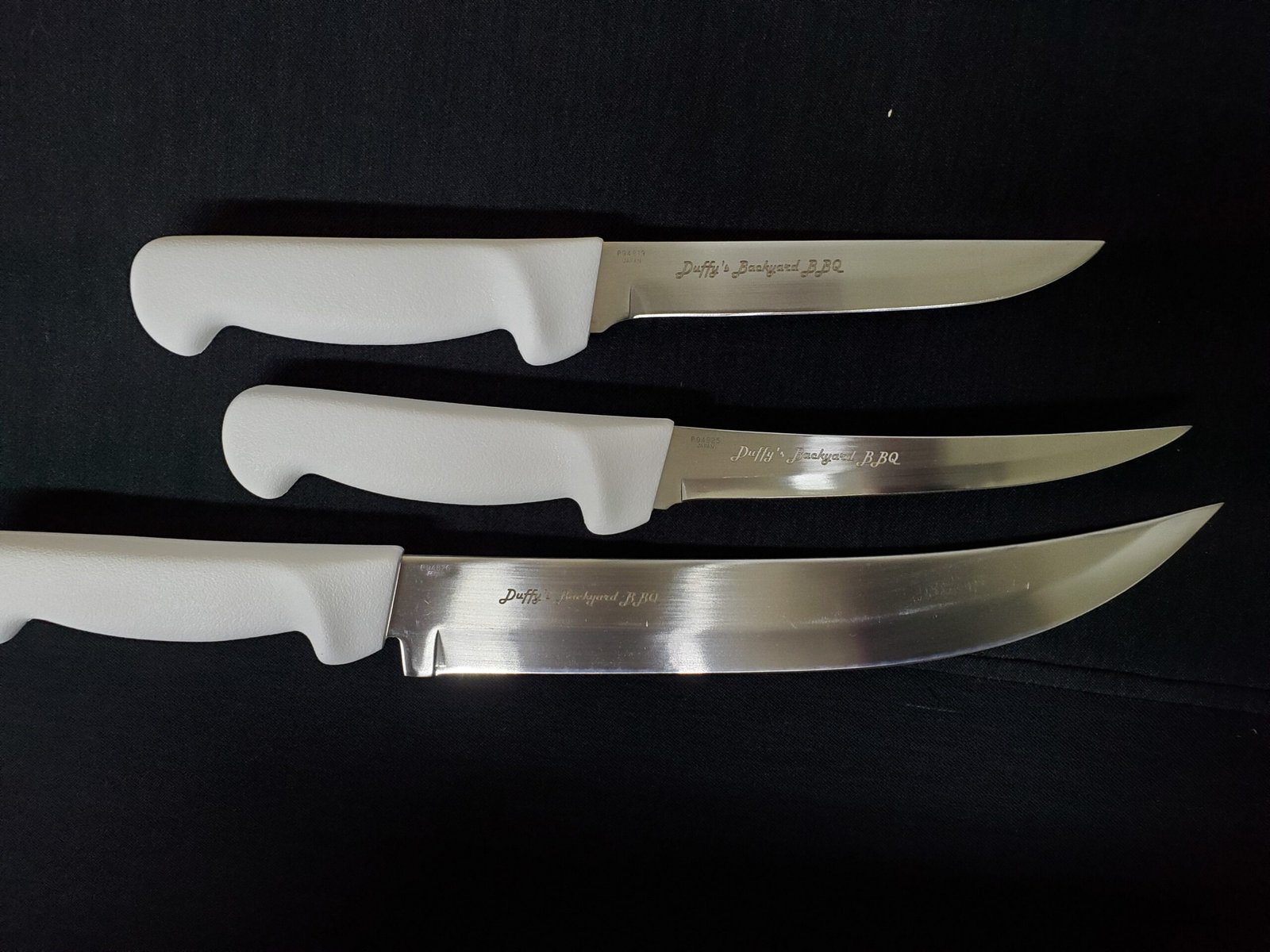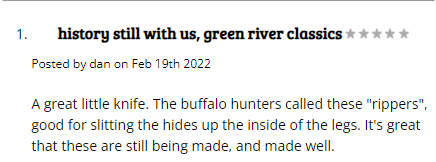DR Knives is an authorized supplier of Dexter Russell® knives, manufactured by Dexter-Russell, Inc. For the official Dexter-Russell site, please go to: www.dexter1818.com.
Dexter Russell Knives - Best in the Industry
01
High Carbon Steel
Industrial knives are made of rock hard high carbon steel and are sharp like razors
02
Sani-Safe - the famous white handle
You see it everywhere - pizza shops, sub shops, restaurants...almost any commercial kitchen
03
DexSteel
The hard and sharp of high carbon meets the convenience of Stain free - DexSteel, the best of both worlds
Dexter Russell Made in The USA since 1818

Sport Knives
Get your custom engraved sport knives today - visit Fishbone Knives for your very own custom sport knives

Industrial Knives
Engraved knives don't go missing - get your industrial knives engraved at Fishbone Knives

Butcher Knife Set
The ultimate Green River Buffalo Skinner Butcher Set - Order now at Fishbone Knives
Customers Love Dexter Russell Knives



The best tool in the kitchen
Learn more about the world famous Dexter Russell Knives
Boning Knives
How to choose the best boning knife is the second most asked question we get. Read on to get the juicy details on choosing the right boning knife. When it comes to shopping for a boning knife, you may feel overwhelmed by all of the different varieties offered. The basis of choosing the right boning knife starts with the size of the meat you plan to process. The most common sizes used in kitchens range from 5 to 6.5 inches. You likely won’t need anything exceeding 6.5 inches for everyday kitchen cuts.
Next comes all the variations in flexibility, rigidity, wideness or narrowness, and whether or not the blade is curved. First, we will compare stiff and wide blades versus flexible and narrow blades. The wider the boning knife, the less flexibility, so they are perfect for using on less tender meats like pork or chicken. On the other hand, if you have a more tender cut like salmon, roasts, or whole ham, the narrow flexible boning knife is recommended. You want your knife to be able to make fine movements, getting right between the meat and the bone without waste.
Now, whether or not you opt for a curved or a straight edge depends on the meat you are cutting. For example, a fish is generally small with much smaller, complex bones. In this case, a curved boning knife will save you a lot of time. For a larger animal on the other hand, the bones are bigger so a straight boning knife will still be able to get the meat off of the bone in an easy pass.
Chef Knives
The go to knife for most cooks- here’s how to guide on choosing the best chef’s knife for your kitchen. The first thing you may notice when browsing chef’s knives is the varying lengths. Chef’s knives typically come in blade lengths ranging from 6 to 12 inches, although the most commonly used sizes range from 8 to 12 inches. Depending on the amount of precision you want when using your knife, is one factor when choosing blade length. The shorter your knife’s blade, the more control you will have. Although you should not peel with your chef knife, the 6 inch may come in handy if you want a lighter knife and have smaller veggies to dice- especially if you have a lot of them, that way your hand won’t tire as easily. Opt. for an 8 inch knife if the slightly heavier weight and less precision will not affect you.
Next we will discuss what you should be using a chef knife for in your kitchen. As we explain below, a santoku knife is similar to a chef knife but they have their differences. Since a chef’s knife is heavier to hold, and usually has a full tang (metal from blade runs all the way through the handle), it can be used for disjointing some animals, cutting meats, cutting small and large fruits, vegetables, and herbs. Something you should not cut with a chef knife is bone, leave that to a heavier duty knife.
You may also be wondering the difference between a cook knife and a chef knife, low and behold… they are the same exact thing! We know, this rumor has been floating around the internet for some time now, but popular to contrary belief, the terms are interchangeable. Whether you see someone listing their product as a chef knife or a cook knife, just know there are no differences in the type of knife it is.
Butcher Knives
When shopping for the right butcher knife, you’re likely wondering where to start. While butcher’s knives are most commonly found in butchers shops and restaurants, they most definitely serve their purpose for home kitchen use as well.
Butcher’s knives range from 6 to 14 inches, with 7 to 8 inch blades being most popular in home kitchens. The size of meat you plan on cutting will help determine if you should go bigger or smaller with your butcher knife blade size. The longer the blade, however, the less control and precision you will have over your knife. This is why a comfortable handle with good grip is necessary when finding a quality butcher knife.
When it comes to knife style, the butcher knife has a large blade with a curved edge and a clip point on the tip. Common uses for a butcher knife are for butchering and dressing animal carcasses. If you find yourself needing to break down large cuts of meat into more manageable chunks, read on to learn how to choose the best butcher’s knives and browse our best butcher’s knives options
Bread Knives
You may be wondering, why use a bread knife when you could just use a steak knife? Have you ever cut into a fluffy loaf of bread and as you cut down your bread flattens? If you answered yes, then keep reading. You may think it’s inevitable to keep your bread from flattening when you slice it- however, a proper bread knife will ease your troubles. A bread knife is known for its serrated edge, so you can saw back and forth to cut through your bread or any other soft and squishy food without flattening it. The more pronounced the serrations, the better the blade will cut through a soft object. You’ll want to choose a quality knife, since the more flexible a blade is the worse the cut will be. When it comes to sizes or styles of bread knives, it is a personal preference. If you cut large loaves of bread or melons, opt for the 10-inch blade. If you do small-scale baking, choose the 8-inch to save space.
Cleaver Knives
The meat cleaver is both a commercial and home kitchen favorite all over the world. When choosing the perfect cleaver to fit your culinary needs, you will notice that there are heavy duty meat cleavers and light duty Chinese cleavers which have similar uses to a chef knife. What the heavy duty cleaver does best is being able to effortlessly chop through bones, thick cuts of meat, and separating chicken thighs. On the other end of the spectrum, smaller light duty cleavers are great for quickly chopping vegetables, crushing garlic with the wide flat side of the blade, and dicing or mincing meat. When you’ve decided if a heavy duty cleaver versus a light duty cleaver will best fit your needs, the next thing to consider is the knife’s handle and blade material.
Chinese Cleaver
The Chinese cleaver, also known as the Chinese Chef knife, is a kitchen favorite. The Chinese cleaver typically has an 8 inch blade and excels at mincing, slicing, chopping and pounding vegetables (large and small), as well as de-boned small meats like chicken or fish. The Chinese cleaver is different from the Western chef knife because it has a thin rectangular blade and its center of weight is near the tip of the blade for more control when vertically slicing. Unlike the Western chef knife which has its weight centered in the handle, which can cause significantly more hand and wrist fatigue. The Chinese cleaver’s broad blade also allows you to scrape up a large pile of prepared ingredients and throw them right into the mixing bowl or pan to save time. Our recommended guide includes different styles and sizes of Chinese cleavers so you can find the perfect cleaver to fit your culinary need
Fillet Knives
Not sure which fillet knife to use, or to give as a gift? You’re not alone. This is the most asked question that we get – what is the best fillet knife for… Well, hopefully we can answer this question for everyone right now: The truth is, you need 2 types of fillet knives to get the job done. A wide fillet knife has a stiff blade and is great for chopping.
On the flip side, a narrow fillet knife has a flexible blade great for filleting. If you had to choose between one or the other, we would recommend the narrow fillet knife. The more narrow and flexible the blade, the more meat you will be able to salvage while filleting your fish. The reason being, a narrow flexible fillet knife allows you to make fine and precise cuts around and very close to the bone. We also recommend you pair your fillet knife with a sheath so its always on hand while you fish, and stays protected.
Santoku Knives
What is this santoku you speak of and what is it used for? Read on to learn all about the santoku and why you need one in your kitchen. First and foremost, a santoku knife is a Japanese kitchen knife that translates as “three virtues,” which are slicing, dicing, and mincing. You should also know the santoku is often compared to the chef knife, but they have few similarities.
The main features of the santoku knife that sets it apart from the chef knife are: a shorter blade length, very light weight, balanced feel, thin blade, no tip, and they usually don’t have a tang (metal from blade continues all the way through the handle).
A santoku knife may also have something called a granton edge, which is a row of small identical divots that encourage food to release from the blade ensuring a cleaner cut. You may be wondering how? A granton edge creates small air pockets between your food and the blade, helping to release normally sticky foods like raw poultry or fish, cheese, or fruits.
Paring Knives
Do you ever get tired of pulling out your heavy, clunky, chef’s knife every time you need to chop, dice, or slice fruit or vegetables? Paring knives’ petite size make them perfect to whip out for small occasions. You can now easily slice an avocado for your taco or a lime for your margarita without the drama of a chef’s knife. Small scale slicing and dicing is what a paring knife excels at. You will thank yourself later for introducing this convenient little knife into the mix.
Knife Sets
Many people are looking to build a set of functional knives for their kitchen. Whether you are a seasoned chef, or a cook just starting out, we got you covered. Here are some hand picked sets we have chosen for you, loved by many knife connoisseurs and new cooks alike.